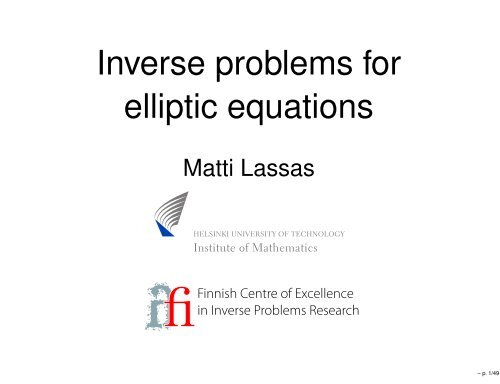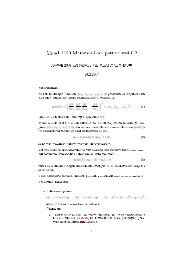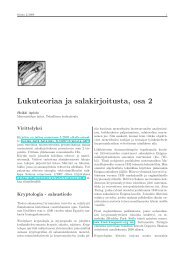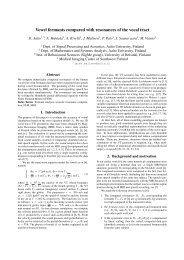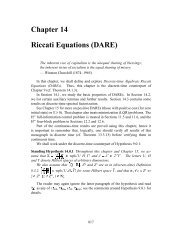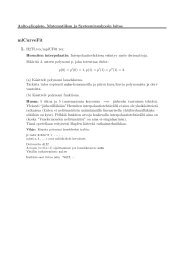Inverse problems for elliptic equations
Inverse problems for elliptic equations
Inverse problems for elliptic equations
Create successful ePaper yourself
Turn your PDF publications into a flip-book with our unique Google optimized e-Paper software.
Mathematical <strong>for</strong>mulation of EIT with unknownboundary:1. Assume that γ is an isotropic conductivity in Ω.2. Assume that we are given a set Ω m that is our bestguess <strong>for</strong> Ω. Let F m : Ω → Ω m be a map correspondingto the modeling error.3. The given data is the electrode measurement matrixE ∈ R J×J .Fact: The de<strong>for</strong>mation F m : Ω → Ω m can change anisotropic conductivity to an anisotropic conductivity.ΩF mΩ m– p. 9/49replacements
4 Anisotropic inverse <strong>problems</strong>Non-uniqueness.Invariant <strong>for</strong>mulation. Uniqueness and non-uniquenessresultsApplications to Euclidean space: non-uniquenessresults.– p. 10/49
De<strong>for</strong>mation of the domain. Assume thatγ(x) = (γ jk (x)) ∈ R n×n ,Let F be diffeomorphism∇· γ∇u = 0 in Ω.F : Ω → Ω,F | ∂Ω = Id.Then∇· ˜γ∇v = 0 in Ω,wherev(x) = u(F −1 (x)), ˜γ(y) = F ∗ γ(y) =(DF )· γ· (DF )tdet (DF )∣∣x=F−1(y)Then Λ eγ = Λ γ .– p. 11/49
Invariant <strong>for</strong>mulation.Assume n ≥ 3. Consider Ω as a Riemannian manifold withg jk (x) = (det γ(x)) −1/(n−2) γ jk (x).Then conductivity equation is the Laplace-Beltrami equation∆ g u = 0 in Ω, wheren∑∆ g u = g −1/2j,k=1∂∂x j (g1/2 g jk∂∂x k u)and g = det (g ij ), [g ij ] = [g jk ] −1 .<strong>Inverse</strong> problem: Can we determine the Riemannianmanifold (M, g) by knowing ∂M andΛ M,g : u| ∂M ↦→ ∂ ν u| ∂M .– p. 12/49
Generally, solutions of anisotropic inverse <strong>problems</strong> are notunique. However, if we have enough a priori knowledge ofthe <strong>for</strong>m of the conductivity, we can sometimes solve theinverse problem uniquely.Manifold (M, g) Boundary measurementsγ jk (x) on Ω ⊂ R n – p. 13/49
Uniqueness resultsTheorem 1 (L.-Taylor-Uhlmann 2003) Assume that (M, g)is a complete n-dimensional real-analytic Riemannianmanifold and n ≥ 3. Then ∂M andΛ M,g : u| ∂M ↦→ ∂ ν u| ∂Mdetermine (M, g) uniquely.Theorem 2 (L.-Uhlmann 2001) Assume that (M, g) is acompact 2-dimensional Riemannian manifold. Then ∂MandΛ M,g : u| ∂M ↦→ ∂ ν u| ∂Mdetermine con<strong>for</strong>mal classuniquely.{(M, αg) : α ∈ C ∞ (M), α(x) > 0}– p. 14/49
5 Anisotropic problem in Ω ⊂ R 2 .Isotropic case:Theorem 3 (Astala-Päivärinta 2003) Let Ω ⊂ R 2 be asimply connected bounded domain and σ ∈ L ∞ (Ω; R + ) anisotropic conductivity function. Then the Dirichlet-to-Neumann map Λ σ <strong>for</strong> the equation∇ · σ∇u = 0determines uniquely the conductivity σ.Next we denote σ ∈ Σ(Ω) if σ(x) ∈ R 2×2 is symmetric,measurable, andC 1 I ≤ σ(x) ≤ C 2 I,<strong>for</strong> a.e. x ∈ Ωwith some C 1 , C 2 > 0.– p. 15/49
Sylvester 1990, Sun-Uhlmann 2003, Astala-L.-Päivärinta2005Theorem 4 Let Ω ⊂ R 2 be a simply connected boundeddomain and σ 1 , σ 2 ∈ L ∞ (Ω; R 2×2 ) conductivity tensors. IfΛ σ1 = Λ σ2 then there is a W 1,2 -diffeomorphismF : Ω → Ω,F | ∂Ω = Idsuch thatσ 1 = F ∗ σ 2 .Recall that if F : Ω → ˜Ω is a diffeomorphism, it trans<strong>for</strong>msthe conductivity σ in Ω to ˜σ = F ∗ σ in ˜Ω,DF (y) σ(y) (DF (y))t˜σ(x) = ∣|det DF (y)|∣y=F−1(x)– p. 16/49
Proof. Identify R 2 = C. Let σ be an anisotropic conductivity,σ(x) = I <strong>for</strong> x ∈ C \ Ω. There is F : C → C such thatγ = F ∗ σis isotropic. There are w(x, k) such that∇· γ∇w = 0 in Candlim w(x,x→∞ k)e−ikx = 1,limk→∞1k log(w(x, k)e−ikx ) = 0.Let u(x, k) = w(F −1 (x), k). The Λ σ determines u(x, k) <strong>for</strong>x ∈ C \ Ω andF −1 (x) = limk→∞log u(x, k)ik, x ∈ C \ Ω.– p. 17/49
Corollaries:1. <strong>Inverse</strong> problem in the half space.Let σ ∈ C ∞ (R 2 −) satisfy 0 < C 1 ≤ σ ≤ C 2 and∇· σ∇u = 0 in R 2 − = {(x 1 , x 2 ) | x 2 < 0}, (1)u| ∂R2−= f, u ∈ L ∞ (R 2 −). (2)Notice that here the radiation condition at infinity (2) is quitesimple. LetΛ σ : H 1/2comp(∂R 2 −) → H −1/2 (∂R 2 −), f ↦→ ν· σ∇u| ∂R2−.– p. 18/49
Corollary 5.1 (Astala-L.-Päivärinta 2005) The map Λ σdetermines the equivalence classE σ = {σ 1 ∈ Σ(R 2 −) | σ 1 = F ∗ σ, F : R 2 − → R 2 − is W 1,2 -diffeo,F | ∂R2−= I}.Moreover, each class E σ contains at most one isotropicconductivity.Thus, if σ is known to be isotropic, it is determined uniquelyby Λ σ .Open problem: <strong>Inverse</strong> problem in R 3 +.– p. 19/49
2. <strong>Inverse</strong> problem in the exterior domain. LetS = R 2 \ D, where D is a bounded Jordan domain. LetWe define∇· σ∇u = 0 in S,u| ∂S = f ∈ H 1/2 (∂S),u ∈ L ∞ (S).Λ σ : H 1/2 (∂S) → H −1/2 (∂S), f ↦→ ν· σ∇u| ∂S .– p. 20/49
Let S ⊂ R 2 , R 2 \ S compact, and denote S = S ∪ {∞}.Corollary 5.2 (Astala-L.-Päivärinta 2005) Let σ ∈ Σ(S).Then the map Λ σ determines the equivalence classE σ,S = {σ 1 ∈ Σ(S) | σ 1 = F ∗ σ, F : S → S is a W 1,2 -diffeo,F | ∂S = I }.Moreover, if σ is known to be isotropic, it is determineduniquely by Λ σ .The group of diffeomorphisms preserving the data do notmap S → S.– p. 21/49
6 Unknown boundary problem in R 2 .1. Assume that γ is an isotropic conductivity in Ω.2. Assume that we are given a set Ω m that is our bestguess <strong>for</strong> Ω. Let F m : Ω → Ω m be a map correspondingto the modeling error.3. We are given the electrode measurement matrixE ∈ R J×J .ΩF mΩ m– p. 22/49placements
Complete electrode model Let e j ⊂ ∂Ω, j = 1, . . . , J bedisjoint open sets (electrodes) and∇· γ∇v = 0 in Ω,eplacements Ωez j ν· γ∇v + v| ej = V j ,jν· γ∇v| ∂Ω\∪Jj=1 e j= 0,where z j are the contact impedances and V j are thepotentials on electrode e j . Measure currentsI j = 1 ∫ν· γ∇v(x) ds(x), j = 1, . . . , J.|e j | e jThis give us electrode measurements matrix E : R J → R J ,E(V 1 , . . . , V J ) = (I 1 , . . . , I J ).– p. 23/49
Continuous model. The electrical potential u satisfy∇ · γ∇u = 0, x ∈ Ω,(zν· γ∇u + u)| ∂Ω = h,where γ is an isotropic conductivity and z is the contactimpedance on the boundary.Boundary measurements are modeled by theRobin-to-Neumann map R = R γ,z given byR γ,z : h ↦→ ν· γ∇u| ∂Ω– p. 24/49
The power needed to maintain the given voltage (V 1 , . . . , V J )or h at boundary are given byp(V ) = E[V, V ],p(h) = R[h, h],where we have quadratic <strong>for</strong>msE[V, Ṽ ] =J∑(EV ) j Ṽ j |e j |, R[h, ˜h] =j=1∫∂Ω(Rh) ˜h ds.The <strong>for</strong>m E[ · , · ] can be viewed as a discretization of R[ · , · ].– p. 25/49
Let F m : Ω → Ω m be de<strong>for</strong>mation of the domain andf m = F m | ∂Ω . On ∂Ω m we define˜R = (f m ) ∗ R γ,z .Then the quadratic <strong>for</strong>m R corresponding to the powerneeded to have the given voltage on the boundary satisfies˜R[h, h] = R[h ◦ f m , h ◦ f m ], h ∈ H −1/2 (∂Ω m ).Thus the electrode measurement matrix on ∂Ω mcorresponds in the continuous model to the mapFact: ˜R = R eγ,ez where˜R = (f m ) ∗ R γ,z .˜γ = (F m ) ∗ γ, ˜z = (F m ) ∗ z.– p. 26/49
Thus the boundary map ˜R on ∂Ω m is equal to R eγ,ez thatcorresponds to boundary measurements made with ananisotropic conductivity ˜γ = (F m ) ∗ γ in Ω m and ˜z = z ◦ f −1m .Assume we are given Ω m and ˜R. Our aim is to find aconductivity tensor in Ω m that is as close as possible to anisotropic conductivity and has the Robin-to-Neumann map˜R.ΩF mΩ m– p. 27/49acements
Definition 6.1 Let γ = γ jk (x) be a matrix valuedconductivity. Let λ 1 (x) and λ 2 (x), λ 1 (x) ≥ λ 2 (x) be itseigenvalues. Anisotropy of γ at x isK(γ, x) =( ) 1/2 λ1 (x) − λ 2 (x).λ 1 (x) + λ 2 (x)The maximal anisotropy of γ in Ω isK(γ) = sup K(γ, x).x∈Ω– p. 28/49
The anisotropy function K(̂γ, x) is constant <strong>for</strong>()λ 1/2 0̂γ(x) = η(x)R θ(x)0 λ −1/2 R −1θ(x)whereλ ≥ 1,η(x) ∈ R + ,(cos θR θ =− sin θsin θcos θ).We say that ̂γ = ̂γ λ,θ,η is a uni<strong>for</strong>mly anisotropic conductivity.– p. 29/49
Theorem 6.2 (Kolehmainen-L.-Ola 2005) Let Ω ⊂ R 2 be abounded, simply connected C 1,α –domain, γ ∈ L ∞ (Ω, R) beisotropic conductivity, and z ∈ C 1 (∂Ω) be the contactimpedance.Let Ω m be a model domain and f m : ∂Ω → ∂Ω m be aC 1,α –diffeomorphism.Assume that we know ∂Ω m and ˜R = (f m ) ∗ R γ,z . These datadetermine ˜z = z ◦ fm−1 and an anisotropic conductivity σ onΩ m such that1. R σ,ez = ˜R.3. If σ 1 satisfies R σ1 ,ez = ˜R then K(σ 1 ) ≥ K(σ).Moreover, the conductivity σ is uni<strong>for</strong>mly anisotropic.– p. 30/49
Algorithm:In following, we assume that z = 0 and denote R σ = R σ,z .The conductivity σ = ̂γ λ,η,θ can obtained by solving theminimization problemmin λ,(λ,θ,η)∈Swhere S = {(λ, θ, η) : R bγ(λ,θ,η) = ˜R}.In implementation of the algorithm we approximate this bymin ‖R bγ(λ,θ,η) − ˜R‖ 2 + ε 1 |λ − 1| 2 + ε 2 (‖θ‖ 2 + ‖η‖ 2 ).(λ,θ,η)– p. 31/49
Let f m : ∂Ω → ∂Ω m be the boundary modeling map and σbe the conductivity with the smallest possible anisotropysuch that R σ = ˜R. ThenCorollary 6.3 Then there is a unique mapF e : Ω → Ω m ,F e | ∂Ω = f mdepending only on f m : ∂Ω → ∂Ω m such thatdet (σ(x)) 1/2 = γ(Fe−1 (x)).acementsF m– p. 32/49ΩΩ m
Idea of the proof. If F : Ω → Ω is a diffeomorphism and γ 1is an isotropic conductivity, thenwhereK(F ∗ γ 1 , x) = |µ F (x)|µ F = ∂F∂F , ∂ = 1 2 (∂ x 1− i∂ x2 ).To find the minimally anisotropic conductivity we need tofind a quasicon<strong>for</strong>mal map with the smallest possibledilatation and the given boundary values. This is called theTeichmüller map.– p. 33/49
1 2 0.78 1.410.03 1.3 0.77 1.41– p. 34/49
0.05 8.080.2 16.06 0.55 8.23– p. 35/49
7 Unknown boundary problem in R 3 .The electrical potential u satisfies∇ · γ∇u = 0, x ∈ Ω ⊂ R 3 ,(zν· γ∇u + u)| ∂Ω = h,where γ is an isotropic conductivity and z is the contactimpedance on the boundary.The boundary measurements are modeled by theRobin-to-Neumann map R = R z,γ given byR γ,z : h ↦→ ν· γ∇u| ∂ΩAgain, let f m : ∂Ω → ∂Ω m be the modeling of boundary and˜R = (f m ) ∗ R γ,z .– p. 36/49
Theorem 5 (Kolehmainen-L.-Ola 2006) Let Ω ⊂ R n , n ≥ 3be a bounded, strictly convex, C ∞ –domain. Assume thatγ ∈ C ∞ (Ω) is an isotropic conductivity, z ∈ C ∞ (∂Ω), z > 0 isthe contact impedance, and R γ,z is the Robin-to-Neumannmap.Let Ω m be a model domain and f m : ∂Ω → ∂Ω m be adiffeomorphism.Assume that we are given ∂Ω m , the values of the contactimpedance z(f −1m (x)), and the map ˜R = (f m ) ∗ R γ,z .Then we can determine Ω upto a rigid motion T and theconductivity γ ◦ T −1 on the reconstructed domain T (Ω).– p. 37/49
Idea of the proof: Let γ be the isotropic conductivity on Ω,˜γ = (F m ) ∗ γ, F m | ∂Ω = f m . Let ˜g be the metric in Ω mcorresponding to the conductivity ˜γ.˜R = R eγ,ez determine the contact impedance ˜z and themetric ˜g on boundary ∂Ω m .˜z(x) and z(f −1m (x)) determine β = det (Df −1m ).˜g and β determine γ ◦ f −1m on boundary ∂Ω m .On ∂Ω m we find the metric corresponding to theEuclidean metric of ∂Ω. This determines by theCohn-Vossen rigidity theorem the strictly convex set Ωup to a rigid motion T .In T (Ω) we solve an isotropic inverse problem.– p. 38/49
Consider now the following algorithm:Data: Assume that we are given ∂Ω m , ˜R = (f m ) ∗ R γ,z andz ◦ f −1m on ∂Ω m .Aim: We look <strong>for</strong> a metric ˜g corresponding to theconductivity ˜γ and ˜z such that ˜R = R eγ,ez and ˜z = z ◦ f −1m .Idea: We look <strong>for</strong> a metric ˜g in Ω m and ρ ∈ C ∞ (Ω m ) suchthatg ij (x) = e 2ρ(x)˜g ij (x)is flat.– p. 39/49
Algorithm:1. Determine the two leading terms in the symbolicexpansion of ˜R. They determine a contact impedance ẑ anda metric ĝ on ∂Ω m such that if ˜R = R eγ,ez then ˜z = ẑ and˜g| ∂Ωm = ĝ.2. Compute the ratio of reconstructed i.e. ẑ, and measuredcontact impedancesβ(x) :=z(f−1m (x)), x ∈ ∂Ω m .ẑ(x)Then β =dS ∂Ωm(f m ) ∗ dS ∂Ω.– p. 40/49
3. Let dS bg be the volume <strong>for</strong>m of ĝ on ∂Ω m and dS E theEuclidean volume on ∂Ω m . ThenDefinedS bg = (det ĝ) 1/2 dS E .̂γ = (det ĝ) 1/2 β.With this choice ̂γ will satisfy ̂γ(x) = γ(f −1m (x)) <strong>for</strong> x ∈ ∂Ω m .4. Define the boundary value ̂ρ <strong>for</strong> the function ρ bŷρ(x) = 12 − n log (̂γ(x)) , x ∈ ∂Ω m.– p. 41/49
5. Solve the minimization problemmin F τ (z, ρ, γ)F τ (z, ρ, γ) = ‖ ˜R − R γ,z ‖ 2 L(H −1/2 (∂Ω m ))+‖z(x)z(f −1 m (x)) − β(x)‖ L 2 (∂Ω m ) + ‖ ρ| ∂Ωm − ̂ρ ‖ 2 L 2 (∂Ω m )++τ‖C‖ 2 L 2 (Ω m )n∑‖ρ ,ij −(−Ric ij + 1 4 g ijR − 1 )2 g ijg lm ρ ,l ρ ,ki,j=1‖ 2 L 2 (Ω m )where τ ≥ 0, g is the metric corresponding to γ, Ric and Rare the Ricci curvature and scalar curvature of g, andC ij = g kp g lq ∇ k (Ric li − 1 4 R g li)ɛ pqj is Cotton-York tensor.– p. 42/49
6. Find the flat metricg ij (x) = e 2ρ(x) g ij (x) = (F m ) ∗ (δ ij )on Ω m and determine the geodesics with respect to themetric g.These give us the the embedding Fm−1 : Ω m → Ω. This givesus Ω upto a rigid motion and the conductivity γ on it.acementsΩ Ω m– p. 43/49
Theorem 6 (Kolehmainen-L.-Ola 2006) Let Ω ⊂ R 3 be abounded, strictly convex, C ∞ –domain. Let γ ∈ C ∞ (Ω) is anisotropic conductivity, z ∈ C ∞ (∂Ω), z > 0 be a contactimpedance.Let Ω m be a model domain and f m : ∂Ω → ∂Ω m be aC ∞ –smooth diffeomorphism.Assume that we are given ∂Ω m , the values of the contactimpedance z(f −1m (x)), x ∈ ∂Ω m , and the map ˜R = (f m ) ∗ R γ,z .Let τ ≥ 0. Then the minimizers ˜z, ˜ρ and ˜γ of F τ (˜z, ˜ρ, ˜γ)determine Ω, z, and γ up to a rigid motion.– p. 44/49
<strong>Inverse</strong> <strong>problems</strong> <strong>for</strong> con<strong>for</strong>mally Euclidean metric.We say that metric g is con<strong>for</strong>mally flat ifg ij (x) = α(x)g ij (x),where metric g ij (x) is flat.Open problem: Can we determine a con<strong>for</strong>mally flat metricin Ω m from its Robin-to-Neumann map?If this is true, then one can solve the inverse problem withan unknown boundary also <strong>for</strong> non-convex domains.– p. 45/49
8 Maxwell’s <strong>equations</strong>.In Ω ⊂ R 3 Maxwell’s <strong>equations</strong> are∇ × E = −B t , ∇ × H = D t ,D = ɛ(x)E, B = µ(x)H in Ω × R.Let M be a 3-dimensional manifold and ɛ(x) and µ(x) metrictensors that are con<strong>for</strong>mal to each other. Maxwell<strong>equations</strong> in time-domain aredE = −B t , dH = D t , D = ∗ ɛ E, B = ∗ µ H in M × R,E| t
Boundary measurements:Assume we are given ∂Ω andZ : n × E| ∂Ω×R+ → n × H| ∂Ω×R+ ,Invariant <strong>for</strong>mulation: Assume we are given ∂M andZ : i ∗ E| ∂M×R+ → i ∗ H| ∂M×R+ ,where i is the imbedding i : ∂M → M.– p. 47/49
Theorem 8.1 [Kurylev-L.-Somersalo 2005] Let M be acompact connected 3-manifold and ɛ and µ be metrictensors con<strong>for</strong>mal to each others. Assume that we aregiven Γ ⊂ ∂M and restriction ofZ Γ : i ∗ E| ∂M×R+ → i ∗ H| Γ×R+<strong>for</strong> i ∗ E| ∂M×R+ ∈ C ∞ 0 (Γ × R +). Then we can find M and ɛ, µon M.Corollary 8.2 Assume that M ⊂ R 3 and ɛ and µ are scalarfunctions. Then Γ and Z Γ determine uniquely (M, ɛ, µ).Sfrag replacementsMΓ– p. 48/49
Proof. We can focus the B-field to a single point:Lemma 8.3 Let T > 0 be a sufficiently large time. Then byusing ∂M and map Z ∂M we can find all sequences ofboundary values i ∗ E k | ∂M×R+ , k = 1, 2 . . . such that <strong>for</strong> somey ∈ M and A ∈ T ∗ y Mlimk→∞ B k(x, T ) = d(Aδ y ) in D ′ (M). (3)The set of focusing sequences{(i ∗ E k ) ∞ k=1 : the limit (3) exists} ⊂ (L2 (∂M)) Z +can be identified with the tangent bundle T M of M,T M = {(y, A) : y ∈ M,A is a tangent vector of M at y}.– p. 49/49


